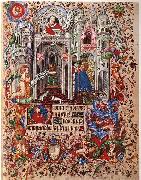La Peinture à l'huile en gros de Chine & Encadre |
|||||||||||

|
|||||||||||
|
|
|
||||||||||||||
|
|
||||||||||||||
|
||||||||||||||
|
|
||||||||||||||
| unknow artist
Parisian_Book_of_Hours 1405-10 Illumination on parchment British Museum, London This page, the opening page of the Hours of the Virgin, is from a Parisian Book of Hours. The artist has been identified as an Italian called Zebo da Firenze. In the opening years of the fifteenth century, the importance of Italian ideas in French manuscript painting is clear, with fresh experiments in landscape, with the introduction of architectural portraiture and occasionally with the transposition to the manuscript page of compositions derived from Italian wall-painting. A significant innovation was the introduction of Italianate acanthus leaves into the borders of traditional spiky ivy-leaf. One Italian manuscript painter can certainly be traced to France. He was called Zebo da Firenze and worked probably in Paris during the beginning of the fifteenth century. In the page from a Parisian Book of Hours he tended to engulf the text in a mass of decorative acanthus liberally interspersed with putti. His narrative scenes were not always confined to a restricted area but sometimes spilled over into the border after the Italian manner. , MINIATURIST, Italian , Parisian Book of Hours , 1401-1450 , Italian , illumination , religious 1405-10 Illumination on parchment British Museum, London This page, the opening page of the Hours of the Virgin, is from a Parisian Book of Hours. The artist has been identified as an Italian called Zebo da Firenze. In the opening years of the fifteenth century, the importance of Italian ideas in French manuscript painting is clear, with fresh experiments in landscape, with the introduction of architectural portraiture and occasionally with the transposition to the manuscript page of compositions derived from Italian wall-painting. A significant innovation was the introduction of Italianate acanthus leaves into the borders of traditional spiky ivy-leaf. One Italian manuscript painter can certainly be traced to France. He was called Zebo da Firenze and worked probably in Paris during the beginning of the fifteenth century. In the page from a Parisian Book of Hours he tended to engulf the text in a mass of decorative acanthus liberally interspersed with putti. His narrative scenes were not always confined to a restricted area but sometimes spilled over into the border after the Italian manner. , MINIATURIST, Italian , Parisian Book of Hours , 1401-1450 , Italian , illumination , religious |
||||||||||||||
|
Related Paintings to unknow artist :. |
||||||||||||||
|
|
||||||||||||||
|
|
||||||||||||||
|
CONTACTER DES Etats-Unis |







